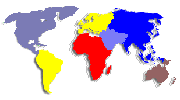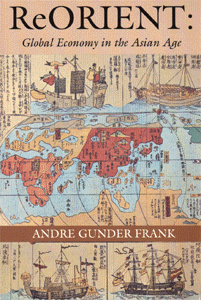|

ReORIENT:
GLOBAL ECONOMY IN THE ASIAN AGE
by Andre Gunder Frank
(University of California Press)
Author`s General Abstract
This book outlines and analyzes the global economy and its sectoral and regional division of labor and cyclical dynamic from 1400 to 1800. The evidence and argument are that within this global economy Asians and particularly Chinese were preponderant, no more »traditional« than Europeans, and in fact largely far less so. The historical documentation poses an »emperor has no clothes« challenge to all received Eurocentric historiography and social theory from Montesquieu, Marx and Weber, or Toynbee and Polanyi, to Rostow, Braudel and Wallerstein. The books`s global economic analysis offers a more holistic theoretical alternative.
»The Rise of the West« was not due to any »European Miracle exceptionalism« that allegedly permitted it to pull itself up by its own bootstraps as Weberians have contended. Nor did Europe build a »European world-economy around itself« a la Braudel and thereby as per Marx and Wallerstein (as well as my own World Accumulation 1492-1789) initiating a European centered »Modern Capitalist World-System« primarily by exploiting the wealth of its American and African colonies. Instead, Europe used its American silver to buy itself marginal entry into the long since existing world market in Asia, which was much larger, more productive and competitive, continued to expand much faster until 1800, and was able to support a rate of population growth in Asia that was than double that of Europe until 1750.
Then changing world economic/ demographic/ ecological relations and relative factor prices in the competitive global economy resulted in the temporary »Decline of the East« and the opportunity for the also temporary »The Rise of the West«. Europe took advantage of this world economic opportunity through import substitution, export promotion and technological change to become Newly Industrializing Economies after 1800, as again happening today in East Asia. That region is now regaining its »traditional« dominance in the global economy, with the Chinese »Middle Kingdom« again at its »center«.
Detailed Chapter-by-Chapter Abstracts
The Preface gives an account of the 40 years over which the ideas of this book have developed, from dependence theory, to world system theory to the present globalism. It refers specifically not only to the various stages of the work by Frank, but also its mutual interaction with that of other contemporary authors, such as Abu-Lughod, Amin, Arrighi, Bergesen, Blaut, Chase-Dunn, Chaudhuri, Chew, Denemark, Ekholm, Friedman, Gills, Hall, Hodgson, McNeill, Wallerstein, and Wolf.
The Chapter 1 Introduction presents the »unity in diversity« theme of this book and its general idea that the whole is more than the sum of, and also shapes, its parts and their relations. It applies this ground rule to the study of the global economy and world system between 1400 and 1800, which this book analyzes as an alternative to the past two centuries of Eurocentric historiography and social theory. The chapter contains very critical examinations of the work of classical authors such as Durkheim, Maine, Marx, Smith, Sombart, Toynbee, and Weber. It also reviews and challenges twentieth century economic historians and social theorists in general and in particular the resistance to the present thesis by Abu-Lughod, Amin, Arrighi, Bairoch, Blaut, Braudel, Brenner, Chase-Dunn and Hall, Chaudhuri, Cipolla, Gates, Jones, Landes, McNeill, Mann, Modelski and Thompson, North, O`Brien, Parsons, Polanyi, Redfield, Rostow, Sanderson, Wallerstein, White, and Wolf. On the other hand, the chapter recommends as complementary to the present book the recent and oft still unpublished work of Asiniero, Fletcher, Hodgson, Perlin, Pomeranz, and Wong.
Chapter 2 examines the structure and flow of trade, starting in the Americas and going eastward literally around the globe. It examines the pattern of trade imbalances, and their settlement through payment in money, which also flowed predominantly eastward. A dozen regions and their relations with each other are examined, going from the Americas, via Africa and Europe, to and through West-, South-, and Southeast-Asia, to Japan and China and from there both across the Pacific and also back across Central Asia and Russia. This review reveals both information about the strength and growth of these »regional« economies and their trade and monetary relations with each other. It also shows, at least implicitly, what kind of a world economic division of labor existed, expanded, and changed in the early modern period from about 1400 to 1800. At the very least, this chapter demonstrates that there was such world-wide division of labor. It identifies many of the different products and services, sectors and regions, and of course enterprises and »countries« that effectively competed with each other in a single global economy. Thus, we will see that all received economic and social theory based on the neglect or outright denial of this world-wide division of labor is without historical foundation.
Chapter 3 examines the role of money in the world economy as a whole and in shaping the relations among its regional parts. There is a large literature on the flow of money from the silver mines in the Americas to Europe, and there has been some concern also with its onward remittance to Asia. However, insufficient attention has been devoted to macro- and micro-economic analysis of why the specie was produced, transported, minted, re-minted, exchanged, etc. Beyond macro- and micro-economic analysis of this production and exchange of silver and other species as commodities, one section of this chapter also examines the very circulatory system through which the monetary blood flowed. Moreover, this monetary system is itself shown to have played an essential role in connecting and expanding the world economy.
Thus, another section examines why and how this capillary monetary system, as well as the oxygen carrying monetary blood that flowed through it, penetrated and fuelled the economic body of the world economy. We examine how some of these monetary veins and arteries were bigger than others, and how smaller ones reached farther into, and even served to extend and stimulate production on, the outward reaches of the world economic body at this and that, but not every, frontier. The hoary myth about Asiatic »hoarding« of money is shown to be without foundation, especially in the »sinks« of the world monetary supply in India, and even more so in China.
Chapter 4 examines some quantitative global economic dimensions. Although hard data are hard to come by, one section devotes some effort to assembling and comparing at least some world-wide and regional dimensions of population, production, trade, and consumption, as well as their respective rates of growth, especially in Asia and Europe. We will see that not only were various parts of Asia economically far more important in and to the world economy than all of Europe. The historical evidence also demonstrates unequivocally that Asia grew faster and more than Europe and maintained its economic lead over Europe in all these respects until at least 1750. If several parts of Asia were richer and more productive than Europe was, and moreover their economies were expanding and growing during this early modern period, how is it possible that the »Asian Mode of Production« under any of its European designations could have been as traditional, stationary, stagnant and generally uneconomic as Marx, Weber, Sombart et al alleged? It was not, and this also Eurocentric proposition should already appear as absurd as it is prima facie. Other sections also bring evidence and the judgements of authorities to bear on comparisons of productivity, technology as well as of economic and financial institutions in Europe and Asia, especially with India and China. These comparisons show that the European put-down of Asia is unfounded in fact; for Asia was not only economically and in many ways technologically ahead of Europe at the beginning but still also at the end of this period. However, this chapter also launches the argument that production, trade, their institutions and technology should not only be inter-nationally compared, but that they must also be seen as being mutually related and generated on a world economic level.
Chapter 5 proposes and pursues a »horizontally integrative macrohistory« of the world, in which simultaneity of events and processes is no coincidence. Nor are simultaneous events here and there seen as differently caused by diverse local »internal« circumstances. Instead, one section after another inquires into common and connected causes of simultaneous occurrences around the world. Demographic/structural, monetary, Kondratieff and longer cycle analysis is brought to bear in different but complementary attempts to account for and explain what was happening here and there. Such cyclical and monetary analysis is used to help account in the 1640s for the simultaneous fall of the Ming in China and of revolution in England, rebellion in Spain and Japan, and other problems in Manila and elsewhere. The French, Dutch Batavian, American, and industrial revolutions in the late eighteenth century are also briefly examined in cyclical and related terms. Another section inquires whether the so-called »seventeenth century crisis« of Europe was world wide and included Asia; and I explore the important significance of a negative answer for world economic history. Observation of the continuation of the »long sixteenth century« expansion through the seventeenth and into part of the eighteenth century in much of Asia is used also to pose the question of whether there were very long, about 500 year long, world economic and political cycles.
Chapter 6 opens with this question about very long cycles opens on how and why the West »won« in the nineteenth century, and whether this »victory« is likely to endure or to be only temporary. In previous works (Gills and Frank 1992, Frank and Gills 1993, Frank 1993), I claim to have identified half-millennium long world economic system wide cycles of expansive »A« and contractive »B« phases, which were some two-three hundred years long each. I traced these back to 3000 BC and up to about 1450 AD. Three separate test attempts by other scholars (cited below) offer some confirmatory evidence of the existence and my dating of these alleged cycles and their phases. Did this pattern of such long cycles continue into early modern times? That is the first question posed in this section. The second one is that, if they did, do they reflect and can they help account for the continued dominance of Asia in the world economy through the seventeenth and into the eighteenth century, as well as for its decline and Europe`s rise thereafter? The chapter also culminates the book`s historical account and theoretical analysis to argue how the »Decline of the East« and the »Rise of the West« may have been systemically related and mutually promoted. To do so, one section examines the unequal regional and sectoral structure and the uneven temporal or cyclical dynamic of the growth of production and of population in the single global economy. The argument is that not Asia`s alleged weakness and Europe`s alleged strength in the period of early modern world history, but rather the effects of Asia`s strength led to its decline after 1750 and that Europe`s actions reflected the weakness of its previously marginal position in the world economy and led to its ascendance after 1800. This development also took advantage of the »Decline of Asia« after 1750, whose roots and timing are also examined in a separate section of the chapter. Moreover, the suggestion is made that within the same still continuing process of global development, a possible twenty-first century reversion of the balance of economic, political and cultural power to Asia may already have begun again. »The Rise of the West« is also examined more concretely in the last section. My thesis - echoing but extending that of James Blaut - is that the West first bought itself a third class seat on the Asian economic train, then leased a whole railway carriage, and only in the nineteenth century managed to displace Asians from the locomotive. One section examines, and cites the analysis of Adam Smith about how the Europeans managed to do so with the use of American money. They used it not only to expand their own economies, but also or even especially to buy themselves into the expanding market in Asia. Thus, the industrial revolution and its eventual use by the Europeans to achieve a position of dominance in the world economy cannot be adequately explained on the basis only of factors »internal« to Europe, not even supplemented by colonially based accumulation of capital. We need a world economic accounting for and explanation of this world economic process and event. This section proposes and then examines a hypothesis based on world-wide and subsidiary regional demand-and-supply relations for labor-saving and power-producing technological innovation.
Chapter 7, the conclusion, re-examines the implications of this need for holistic analysis and our derivative findings and hypotheses for further research about historiography, received theory and the possible and necessary reconstruction of both. That is, since the whole is more than the sum of its parts, each part is not only influenced by other parts, but by what happens in the whole world (system). There is no way we can understand and account for what happened in Europe or America without taking account of what happened in Asia and Africa - and vice versa - nor what happened anywhere without identifying the influences that emanated from everywhere, that is from the structure and dynamic of the whole world (system) itself. In literally a word, we need a holistic analysis to explain any part of the system. The first part of the chapter summarizes the historiographic conclusions of what not to do, especially the divisionism of Fukujama`s »end of history«, »Huntington`s »clash of civilizations«, and Barber`s »Jihad vs. McWorld«. The second part of the final chapter goes on to suggest better alternative theoretical directions for new historiogrpahy and theory to promote unity in diversity.

|




